AP BIO CHAPTER 8: Photosynthesis
Introduction
8.1 Photosynthesis converts light energy to the chemical energy of food
8.2 The light reactions convert solar energy to the chemical energy of ATP and NADPH
8.3 The Calvin cycle uses the chemical energy of ATP and NADPH to reduce CO2 to sugar
BIG IDEAS: Photosynthetic organisms capture free energy present in sunlight (Big Idea 2), which is then available to heterotrophic organisms within a community as energy flows from one organism to another (Big Idea 4). The core processes that define this interaction are enabled by cellular structures that evolved early on that enable the capture, storage, and use of free energy (Big Idea 1).
[[Photosynthesis:[[
The conversion of light energy to chemical energy that is stored in sugars or other organic compounds
Where does photosynthesis occur?
It occurs in plants, algae, and certain prokaryotes
[[Autotrophs:[[
An organism that obtains organic food molecules without eating other organisms or substances derived from other organisms. Autotrophs use energy from the sun or from the oxidation of inorganic substances to make organic molecules from inorganic ones
Biologists refer to autotrophs as the ___of the biosphere
- producers
[[Heterotrophs:[[
An organism that obtains organic food molecules by eating other organisms or substances derived from them
Heterotrophs are the biosphere’s ___
- consumers
Almost all heterotrophs, including humans, are completely dependent, either directly or indirectly, on ___
- photoautotrophs for food—and also for oxygen, a by-product of photosynthesis.
^^Concept 8.1: Photosynthesis converts light energy to the chemical energy of food^^
In eukaryotes that are autotrophs, photosynthesis occurs in chloroplasts, organelles containing thylakoids. Stacks of thylakoids form grana. Photosynthesis is summarized as 6CO2 + 12H2O + Light Energy → C6H12O6 + 6O2 + 6H2O
Chloroplasts split water into hydrogen and oxygen, incorporating the electrons of hydrogen into sugar molecules. Photosynthesis is a redox process: H2O is oxidized, and CO2 is reduced. The light reactions in the thylakoid membranes split water, releasing O2, producing ATP, and forming NADPH. The Calvin cycle in the stroma forms sugars from CO2, using ATP for energy and NADPH for reducing power.
All ___ parts of a plant have _
- green; chloroplasts
[[Mesophyll:[[
Leaf cells specialized for photosynthesis
Where is the mesophyll located in C3 and CAM plants?
Between the upper and lower epidermis
Where is the mesophyll located in C4 plants?
Between the bundle-sheath cells and the epidermis
[[Stomata (Singular Stoma):[[
A microscopic pore surrounded by guard cells in the epidermis of leaves and stems that allows gas exchange between the environment and the interior of the plant
Zooming in on the location of photosynthesis in a plant
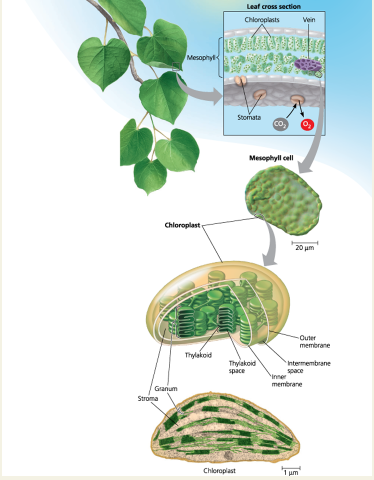
A typical mesophyll cell has about ___ chloroplasts, each measuring about _
- 30-40; 2–4 μm by 4–7 μm
[[Stroma:[[
The dense fluid within the chloroplast surrounding the thylakoid membrane and contain ribosomes and DNA; is involved in the synthesis of organic molecules from carbon dioxide and water
[[Thylakoid:[[
A flattened, membranous sac inside a chloroplast; their membranes contain molecular “machinery“ used to convert light energy to chemical energy
[[Grana:[[
Interconnected stacks that thylakoids often exist in
[[Chlorophyll:[[
A green pigment located in membranes within the chloroplasts of plants and algae in the membranes of certain prokaryotes.
The direct product of photosynthesis is
- a three-carbon sugar that can be used to make glucose
How much water is consumed and newly formed during photosynthesis?
12 molecules are consumed and 6 molecules are newly formed
Simplified photosynthetic equation
CO2 + H2O → [CH2O] + O2
O2 given off by plants is derived from ___
- H2O and not from CO2
Van Niel proposed that all photosynthetic organisms require a hydrogen source but that the source varies

Experiments using oxygen-18 as a tracer

Tracking atoms through photosynthesis

Photosynthesize as a redox reaction
![]()
[[Light Reactions:[[
Convert solar energy to the chemical energy of ATP and NADPH, releasing oxygen in the process; the photo part of photosynthesis
Where do light reactions occur?
These occur on the thylakoid membranes of the chloroplasts or on the membranes of certain prokaryotes
[[Calvin Cycle:[[
Involving fixation of atmospheric CO2 and reduction of the fixed carbon into carbohydrates; the synthesis part of photosynthesis
An overview of photosynthesis: cooperation of the light reactions and the Calvin cycle
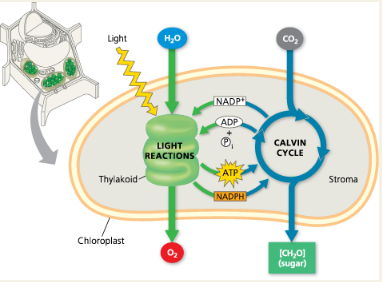
[[NADP+:[[
Nicotinamide adenine dinucleotide phosphate; is an e- acceptor that, as NADPH, temporarily stores energized e- produced during the light reactions
NAD+ and NADP+ differ only by the presence of an ___ in the NADP+ molecule
- extra phosphate group
The light reactions use solar energy to reduce NADP+ to NADPH by adding ___
- a pair of electrons along with an H+
[[Photophosphorylation:[[
The process of generating ATP from ADP and phosphate by means of chemiosmosis, using a proton-motive force generated across the thylakoid membrane of the chloroplast or the membrane of certain prokaryotes during the light reactions of photosynthesis
[[Carbon Fixation:[[
The initial incorporation of carbon from CO2 into an organic compound by an autotrophic organism (a plant, another photosynthetic organism, or a chemoautotrophic prokaryote)
While the Calvin cycle occurs in ___, the _ are the sites of light reactions
- stroma; thylakoids of the chloroplast
How do the reactant molecules of photosynthesis reach the chloroplasts in leaves?
CO2 enters the leaves via stomata, and water enters the plant via roots and is carried to the leaves through veins.
How did the use of an oxygen isotope help elucidate the chemistry of photosynthesis?
Using 18O, a heavy isotope of oxygen, as a label, researchers were able to confirm van Niel’s hypothesis that the oxygen produced during photosynthesis comes from water, not from carbon dioxide.
The Calvin cycle requires ATP and NADPH, products of the light reactions. If a classmate asserted that the light reactions don’t depend on the Calvin cycle and, with continual light, could just keep on producing ATP and NADPH, how would you respond?
The light reactions could not keep producing NADPH and ATP without the NADP+, ADP, and ℗i that the Calvin cycle generates. The two cycles are interdependent.
Compare the roles of CO2 and H2O in respiration and photosynthesis.
CO2 and H2O are the products of respiration; they are the reactants in photosynthesis. In respiration, glucose is oxidized to CO2, and electrons are passed through an electron transfer chain from glucose to O2, producing H2O. In photosynthesis, H2O is the source of electrons, which are energized by light, temporarily stored in NADPH, and used to reduce CO2 to carbohydrate.
^^Concept 8.2: The light reactions convert solar energy to the chemical energy of ATP and NADPH^^
Light is a form of electromagnetic energy. The colors we see as visible light include those wavelengths that drive photosynthesis. A pigment absorbs light of specific wavelengths; chlorophyll a is the main photosynthetic pigment in plants. Other accessory pigments absorb different wavelengths of light and pass the energy on to chlorophyll a**.**
A pigment goes from a ground state to an excited state when a photon of light boosts one of the pigment’s electrons to a higher-energy electron shell. Electrons from isolated pigments tend to fall back to the ground state, giving off heat and/or light.
A photosystem is composed of a reaction-center complex surrounded by light-harvesting complexes that funnel the energy of photons to the reaction-center complex. When a special pair of reaction-center chlorophyll a molecules absorbs energy, one of its electrons is boosted to a higher energy level and transferred to the primary electron acceptor. Photosystem II contains P680 chlorophyll a molecules in the reaction-center complex; photosystem I contains P700 molecules.
Linear electron flow during the light reactions uses both photosystems and produces NADPH, ATP, and oxygen
Electron Flow in Light Reactions

- During chemiosmosis in both mitochondria and chloroplasts, electron transport chains generate an H+ (proton) gradient across a membrane. ATP synthase uses this proton-motive force to synthesize ATP.
Light is a form of energy known as ___
- electromagnetic energy, also called electromagnetic radiation.
Electromagnetic energy travels in ___
- rhythmic waves analogous to those created by dropping a pebble into a pond.
Electromagnetic waves are ___
- disturbances of electric and magnetic fields rather than disturbances of a material medium such as water.
[[Wavelength:[[
The distance between crests of waves, such as those of the elctromagnetic spectrum
[[Electromagnetic Spectrum:[[
The entire spectrum of electromagnetic radiation, rangin in wavelength from less than a nanometer to more than a kilometer
[[Visible Light:[[
The portion of the electromagnetic spectrum that can be detected as various colors by the human eye, ranging in wavelength from about 380 nm to about 750 nm
The Electromagnetic Spectrum Diagram

[[Photons:[[
A quantum, or discrete quantity, of light energy that behaves as if it were a particle
The amount of energy is ___ related to the wavelength of the light: _
- inversely; The shorter the wavelength, the greater the energy of each photon of that light
[[Pigments:[[
Substances thatabsorb visible light
[[Spectrophometer:[[
An instrument that measures the proportions of light of different wavelengths absorbed and transmitted by a pigment solution
[[Absorption Spectrum:[[
The range of a pigment’s ability to absorb various wavelengths of light; also a graph of such a range
Why leaves are green: interaction of light with chloroplasts
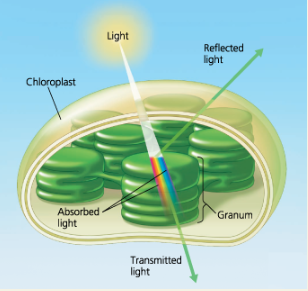
Determining an absorption spectrum
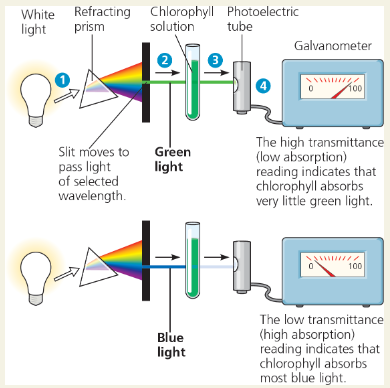
[[Chlorophyll a:[[
A photosynthetic pigment that participates directly in the light reactions, which convert solar energy to chemical energy
[[Chlorophyll b:[[
An accessory photosynthetic pigment that transfers energy to chlorophyll a
[[Action Spectrum:[[
A graph that profiles the relative effectiveness of different wavelengths of rediation in driving a particular process
An action spectrum is prepared by illuminating chloroplasts with light of different colors and then plotting ___ against _ such as CO2 consumption or O2 release
- wavelength; some measure of phtosynthetic rate
Absorption spectra. The three curves show the wavelengths of light best absorbed by three types of chloroplast pigments.
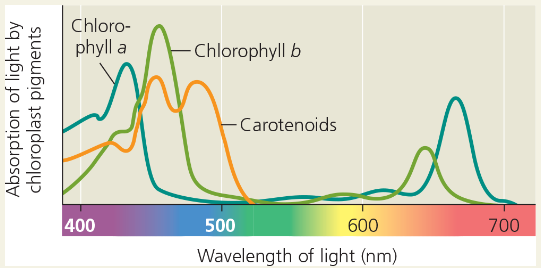
Action spectrum. This graph plots the rate of photosynthesis versus wavelength. The resulting action spectrum resembles the absorption spectrum for chlorophyll a but does not match exactly (see part a). This is partly due to the absorption of light by accessory pigments such as chlorophyll b and carotenoids.
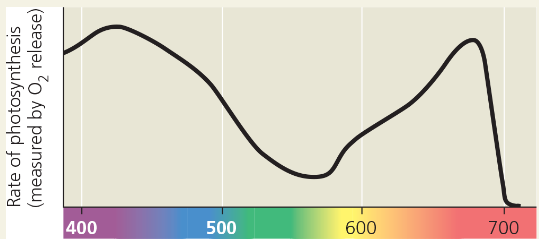
Engelmann‘s experiment. In 1883, Theodor W. Engelmann illuminated a filamentous alga with light that had been passed through a prism, exposing different segments of the alga to different wavelengths. He used aerobic bacteria, which concentrate near an oxygen source, to determine which segments of the alga were releasing the most O2 and thus photosynthesizing most. Bacteria congregated in greatest numbers around the parts of the alga illuminated with violet-blue or red light.
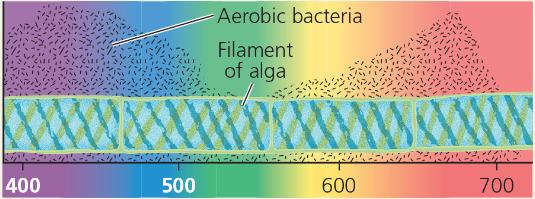
What wavelength of light drive the highest rate of photosynthesis?
Light in the violet-blue and red portions of the spectrum is most effective
Structure of chlorophyll molecules in chloroplasts of plants

[[Carotenoids:[[
An accessory pigment, either yellow or orange, in the chloroplasts of lants and in some prokaryotes.
By absorbing wavelengths of light that chloropjyll cannot, carotenoids ___ the spectrum of colors that can drive photosynthesis
- broaden
[[Photoprotection:[[
How organisms cope with molecular damage caused by sunlight
Caretenoids ___ that would otherwise damage chlroophyll or interact wiht oxygen
- absorb and dissipate excessive light energy
When a molecule absorbs a photon of light, one of the molecule’s electrons is ___ to an electron shell where it has _ potential energy
- elevated; more
When the electron is in its normal shell, the pigment molecule is said to be ___
- in its ground state
The only photons absorbed are those whose energy is ___ to the energy difference between the ground state and an excited state, and this energy difference varies from one kind of molecule to another
- exactly equal
A particular compound absorbs only photons corresponding to ___ which is why each pigment has a unique absorption spectrum.
- specific wavelengths
Excitation of isolated chlorophyll by light
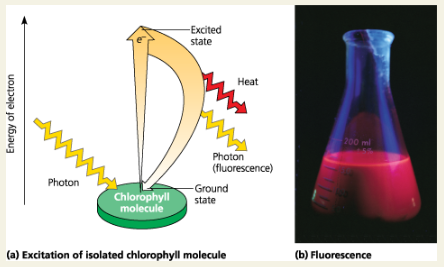
Generally, when isolated pigment molecules absorb light, their excited electrons ___ in a billionth of a second, releasing their excess energy as heat
- drop back down to the ground-state electron shell
[[Photosystem:[[
A light capturing unit located int he thylakoid membrane of the chloroplast or in the membrane of some prokaryotes, consisting of a reaction-center complez surrounded by numeroud light-harvesting complexes
Describe the types of photosystems
There are two types of photosystems, I and II; they absorb light best at different wavelengths
[[Reaction-Center Complex:[[
A complex of proteins associated with a special pair of chlorophyll a molecules and a primary e- acceptor.
Located centrally in a photosystem, reaction-center complexes triggers the ___
- light reactions of photsynthesis.
Excited by ___ the pair of chlorophylls donates an e- to the primary e- acceptor, whcih passes an e- to an ETC
- light energy
[[Light-Harvesting Complex:[[
A complex of proteins associated with pigment molecules (including chlorophyll a, chlorophyll b, and carotenoids) that captures light energy and transfers it to reaction-center pigments in a photosystem
When a pigment molecule absorbs a photon, the energy is transferred ___ somewhat like a human “wave” at a sports arena, until it is passed into the reaction-center complex
- from pigment molecule to pigment molecule within a light-harvesting complex,
[[Primary Electron Acceptor:[[
In the thylakoid membrane of a chloroplast or in the membrane of some prokaryotes, a specialized molecule that shares the reaction-center complex with a pair of chlorophyll a molecules and that accepts an e- from them
The structure and function of a photosystem diagram
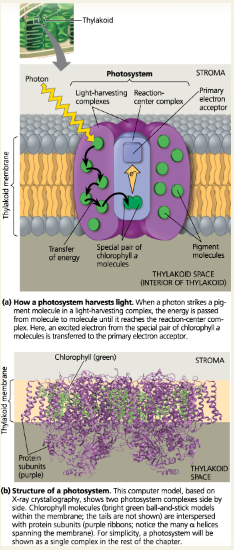
As soon as the chlorophyll electron is excited to a higher energy level, the primary electron acceptor captures it; this is a ___
- redox reaction
[[Photosystem I (PS I):[[
It has two molecules of P700 chlorophyll a at its reaction center; in chloroplast’s thylakoid membrane or in the membrane of some prokaryotes
[[Photosystem II (PS II):[[
It has two molecules of P680 chlorophyll a at its reaction center; in chloroplast’s thylakoid membrane or in the membrane of some prokaryotes
Photosystem ___ functions first in the light reactions
- II
How does the chlorophyll a get its name?
It depends on what wavelength the pigment is best at absorbing (P680 - light at 680 nm in red part of spectrum, P700 - 700 nm in far-red)
[[Linear Electron Flow:[[
A route of e- flow during the light reactions of photosynthesis that involved both photosystems and produces ATP, NADPH, and O2
The net e- flow is from ___
- H2O to NADP+
How linear electron flow during the light reactions generates ATP and NADPH
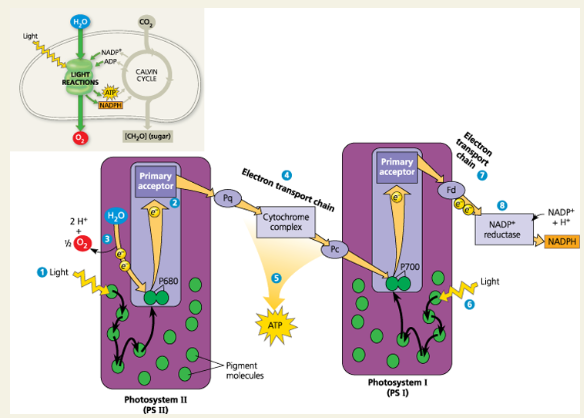
<<Steps of how linear electron flow during the light reactions generates ATP and NADPH<<
- A photon of light strikes one of the pigment molecules in a light-harvesting complex of PS II, boosting one of its electrons to a higher energy level. As this electron falls back to its ground state, an electron in a nearby pigment molecule is simultaneously raised to an excited state. The process continues, with the energy being relayed to other pigment molecules until it reaches the P680 pair of chlorophyll a molecules in the PS II reaction-center complex. It excites an electron in this pair of chlorophylls to a higher energy state.
- This electron is transferred from the excited P680 to the primary electron acceptor. We can refer to the resulting form of P680, missing an electron, as P680+.
- An enzyme catalyzes the splitting of a water molecule into two electrons, two hydrogen ions (H+), and an oxygen atom. The electrons are supplied one by one to the P680+ pair, each electron replacing one transferred to the primary electron acceptor. (P680+ is the strongest biological oxidizing agent known; its electron “hole” must be filled. This greatly facilitates the transfer of electrons from the split water molecule.) The H+ are released into the thylakoid space. The oxygen atom immediately combines with an oxygen atom generated by the splitting of another water molecule, forming O2.
- Each photoexcited electron passes from the primary electron acceptor of PS II to PS I via an electron transport chain, the components of which are similar to those of the electron transport chain that functions in cellular respiration. The electron transport chain between PS II and PS I is made up of the electron carrier plastoquinone (Pq), a cytochrome complex, and a protein called plastocyanin (Pc).
- The exergonic “fall” of electrons to a lower energy level provides energy for the synthesis of ATP. As electrons pass through the cytochrome complex, H+ are pumped into the thylakoid space, contributing to the proton gradient that is then used in chemiosmosis, to be discussed shortly.
- Meanwhile, light energy has been transferred via light-harvesting complex pigments to the PS I reaction-center complex, exciting an electron of the P700 pair of chlorophyll a molecules located there. The photoexcited electron is then transferred to PS I’s primary electron acceptor, creating an electron “hole” in the P700—which we now can call P700+. In other words, P700+ can now act as an electron acceptor, accepting an electron that reaches the bottom of the electron transport chain from PS II.
- Photoexcited electrons are passed in a series of redox reactions from the primary electron acceptor of PS I down a second electron transport chain through the protein ferredoxin (Fd). (This chain does not create a proton gradient and thus does not produce ATP.)
- The enzyme NADP+ reductase catalyzes the transfer of electrons from Fd to NADP+. Two electrons are required for its reduction to NADPH. This molecule is at a higher energy level than water, so its electrons are more readily available for the reactions of the Calvin cycle. This process also removes an H+ from the stroma.
A mechanical analogy for linear electron flow during the light reactions
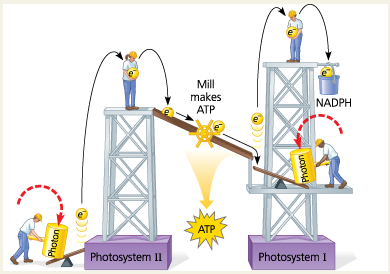
Compare chloroplasts and mitochondria
The inner membrane of the mitochondrion pumps protons from the mitochondrial matrix out to the intermembrane space, which then serves as a reservoir of hydrogen ions. The thylakoid membrane of the chloroplast pumps protons from the stroma into the thylakoid space (interior of the thylakoid), which functions as the H+ reservoir
Comparison of chemiosmosis in mitochondria and chloroplasts

Describe how you would change the pH in order to artificially cause ATP synthesis (a) outside an isolated mitochondrion (assume H+ can freely cross the outer membrane) and (b) in the stroma of a chloroplast. Explain.
You would (a) decrease the pH outside the mitochondrion (thus increasing the H+ concentration) and (b) increase the pH in the chloroplast stroma (thus decreasing the H+ concentration). In both cases, this would generate an H+ gradient across the membrane that would cause ATP synthase to synthesize ATP.
How is the pH gradient across the thylakoid membrane substantial?
When chloroplasts in an experimental setting are illuminated, the pH in the thylakoid space drops to about 5 (the H+ concentration increases), and the pH in the stroma increases to about 8 (the H+ concentration decreases). This gradient of three pH units corresponds to a thousandfold difference in H+ concentration
The light reactions and chemiosmosis: the current model of the organization of the thylakoid membrane
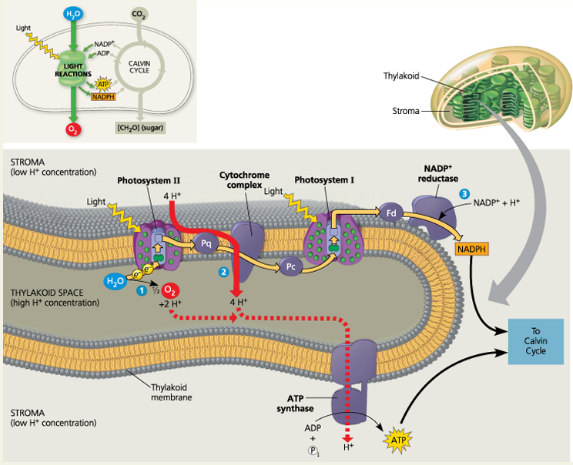
What contributes to the H+ gradient across the thylakoid membrane?
Water is split by photosystem II on the side of the membrane facing the thylakoid space; as plastoquinone (Pq) transfers electrons to the cytochrome complex, four protons are translocated across the membrane into the thylakoid space; and a hydrogen ion is removed from the stroma when it is taken up by NADP+. Notice that hydrogen ions are being pumped from the stroma into the thylakoid space. The diffusion of H+ from the thylakoid space back to the stroma (along the H+ concentration gradient) powers the ATP synthase.
Summarize the light reactions
Electron flow pushes electrons from water, where they are at a low state of potential energy, ultimately to NADPH, where they are stored at a high state of potential energy. The light-driven electron flow also generates ATP. Thus, the equipment of the thylakoid membrane converts light energy to chemical energy stored in ATP and NADPH. (Oxygen is a by-product.) Let’s now see how the Calvin cycle uses the products of the light reactions to synthesize sugar from CO2
What color of light is least effective in driving photosynthesis? Explain.
Green, because green light is mostly transmitted and reflected—not absorbed—by photosynthetic pigments
In the light reactions, what is the initial electron donor? At the end of the light reactions, where are the electrons?
Water (H2O) is the initial electron donor; NADP+ accepts electrons at the end of the electron transport chain, becoming reduced to NADPH.
In an experiment, isolated chloroplasts placed in an illuminated solution with the appropriate chemicals can carry out ATP synthesis. Predict what will happen to the rate of synthesis if a compound is added to the solution that makes membranes freely permeable to hydrogen ions.
The rate of ATP synthesis would slow and eventually stop. Because the added compound would not allow a proton gradient to build up across the membrane, ATP synthase could not catalyze ATP production.
The absorption spectrum of chlorophyll a differs from the action spectrum of photosynthesis. Explain this observation.
The action spectrum of photosynthesis shows that some wavelengths of light that are not absorbed by chlorophyll a are still effective at promoting photosynthesis. The light-harvesting complexes of photosystems contain accessory pigments, such as chlorophyll b and carotenoids, which absorb different wavelengths and pass the energy to chlorophyll a, broadening the spectrum of light usable for photosynthesis.
^^Concept 8.3: The Calvin cycle uses the chemical energy of ATP and NADPH to reduce CO2 to sugar^^
- The Calvin cycle occurs in the stroma, using electrons from NADPH and energy from ATP. One molecule of G3P exits the cycle per three CO2 molecules fixed and is converted to glucose and other organic molecules.
Diagram of Calvin Cycle

On hot, dry days, C3 plants close their stomata, conserving water but keeping CO2 out and O2 in. Under these conditions, photorespiration can occur: Rubisco binds O2 instead of CO2, leading to consumption of ATP and release of CO2 without the production of sugar. Photorespiration may be an evolutionary relic and it may also play a protective role.
C4 plants are adapted to hot, dry climates. Even with their stomata partially or completely closed, they minimize the cost of photorespiration by incorporating CO2 into four-carbon compounds in mesophyll cells. These compounds are exported to bundle-sheath cells, where they release carbon dioxide for use in the Calvin cycle.
CAM plants are also adapted to hot, dry climates. They open their stomata at night, incorporating CO2 into organic acids, which are stored in mesophyll cells. During the day, the stomata close, and the CO2 is released from the organic acids for use in the Calvin cycle.
Organic compounds produced by photosynthesis provide the energy and building material for Earth’s ecosystems.
Compare and contrast the Calvin cycle and citric acid cycle
The Calvin cycle is similar to the citric acid cycle in that a starting material is regenerated after some molecules enter and others exit the cycle. However, the citric acid cycle is catabolic, oxidizing acetyl CoA and using the energy to synthesize ATP, while the Calvin cycle is anabolic, building carbohydrates from smaller molecules and consuming energy
[[Glyceraldehyde 3-Phosphate (G3P):[[
A three-carbon carbohydrate that is the direct product of the Calvin cycle; it is also an intermediate in glycolysis
For net synthesis of one molecule of G3P, the cycle must take place ___ times, fixing _ molecules of CO2—one per turn of the cycle
- three; three
The Calvin Cycle Diagram
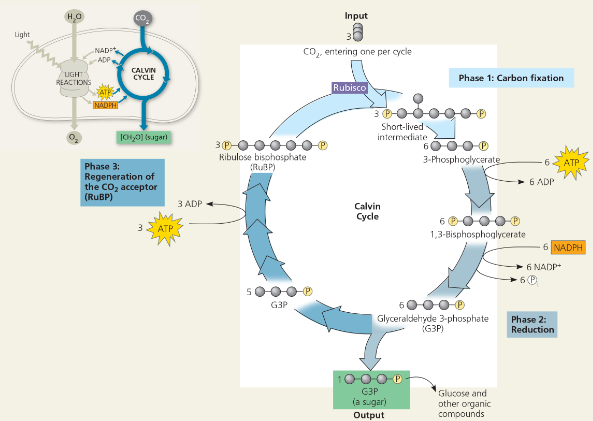
Redraw this cycle using numerals instead of gray balls to indicate the numbers of carbons, multiplying at each step to ensure that you have accounted for all the carbons
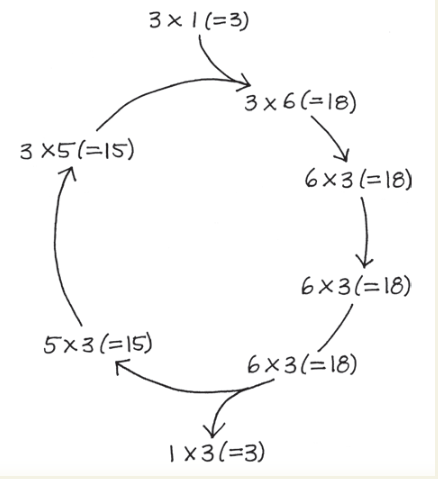
In what forms do the carbon atoms enter and leave the cycle?
Three carbon atoms enter the cycle, one by one, as individual CO2 molecules and leave the cycle in one three-carbon molecule (G3P) per three turns of the cycle.
PHASE 1: CARBON FIXATION
The Calvin cycle incorporates each CO2 molecule, one at a time, by attaching it to a five-carbon sugar named ribulose bisphosphate (abbreviated RuBP). The enzyme that catalyzes this first step is RuBP carboxylase/oxygenase, or rubisco. (This is the most abundant protein in chloroplasts and is also thought to be the most abundant protein on Earth.) The product of the reaction is a six-carbon intermediate so unstable that it immediately splits in half, forming two molecules of 3-phosphoglycerate (for each CO2 fixed).
[[Rubisco:[[
Ribulose biphosphate (RuBP) carboxylase, the enzyme that catalyzes the first step of the Calvin cycle (the addition of CO2 to RuBP)
PHASE 2: REDUCTION
Each molecule of 3-phosphoglycerate receives an additional phosphate group from ATP, becoming 1,3-bisphosphoglycerate. Next, a pair of electrons donated from NADPH reduces 1,3-bisphosphoglycerate, which also loses a phosphate group, becoming G3P. Specifically, the electrons from NADPH reduce a carboxyl group on 1,3-bisphosphoglycerate to the aldehyde group of G3P, which stores more potential energy. G3P is a sugar—the same three-carbon sugar formed in glycolysis by the splitting of glucose. For every three molecules of CO2 that enter the cycle, there are six molecules of G3P formed. But only one molecule of this three-carbon sugar can be counted as a net gain of carbohydrates because the rest are required to complete the cycle. The cycle began with 15 carbons’ worth of carbohydrates in the form of three molecules of the five-carbon sugar RuBP. Now there is 18 carbons’ worth of carbohydrate in the form of six molecules of G3P. One molecule exits the cycle to be used by the plant cell, but the other five molecules must be recycled to regenerate the three molecules of RuBP.
PHASE 3: REGENERATION OF THE CO2 ACCEPTOR (RUBP)
In a complex series of reactions, the carbon skeletons of five molecules of G3P are rearranged by the last steps of the Calvin cycle into three molecules of RuBP. To accomplish this, the cycle spends three more ATPs. The RuBP is now prepared to receive CO2 again, and the cycle continues.
To synthesize one G3P molecule, the Calvin cycle consumes ___ molecules of ATP and _ molecules of NADPH
- nine; six
[[C3 Plant:[[
A plant that uses the Calvin cycle for the initial steps that incorporate CO2 into organic material, forming a three-carbon compound as the first stable intermediate
When their stomata close on hot, dry days, C3 plants produce ___ sugar because the declining level of CO2 in the leaf starves the Calvin cycle
- less
[[Photorespiration:[[
A metabolic pathway that consumes oxygen and ATP, releases carbon dioxide and decreases photosynthetic output
When does photorespiration occur?
Generally on hot, dry, bright days, when stomata close and the O2/CO2 ratio in the leaf increases, favoring the binding of O2 rather than CO2 by rubisco
[[C4 Plant:[[
A plant in which the Calvin cycle is preceded by the reaction that incorporates CO2 into a four-carbon compound, the end product of which supplies CO2 for the Calvin cycle
C4 and CAM Photosynthesis Compared
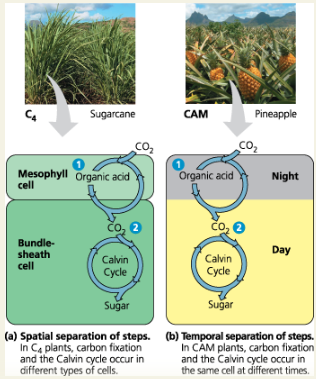
[[Crassulacean Acid Metabolism (CAM):[[
An adaption for photosynthesis in arid conditions. A plant takes up CO2 at night when stomata are open and incorporates it into a variety of organic acids; during the day, when stomata are closed, CO2 is released from the organic acids for use in the Calvin cycle
[[CAM Plant:[[
A plant that uses CAM in arid conditions to convert CO2 to organic acids at night to release for the Calvin cycle during the day
How are ATP and NADP+ used in light reactions?
The light reactions capture solar energy and use it to make ATP and transfer electrons from water to NADP+, forming NADPH. The Calvin cycle uses the ATP and NADPH to produce sugar from carbon dioxide
A review of photosynthesis
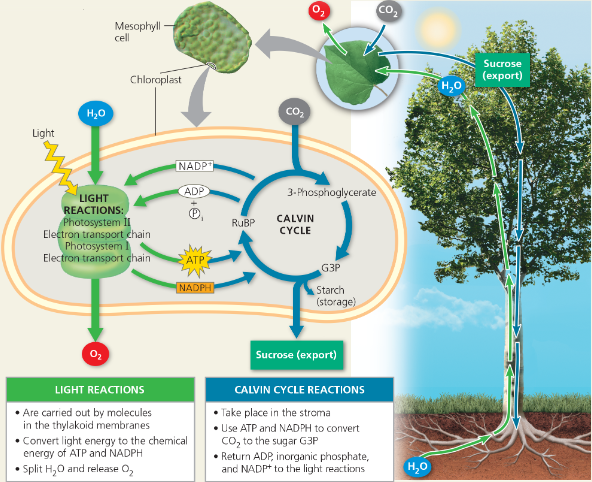
Can plants use the sugar they produce during photosynthesis to power the work of their cells? (See Figures 6.9, 6.10, and 7.6)
Yes, plants can break down the sugar (in the form of glucose) by cellular respiration, producing ATPs for various cellular processes such as endergonic chemical reactions, transport of substances across membranes, and movement of molecules in the cell.
The Working Cell Diagram
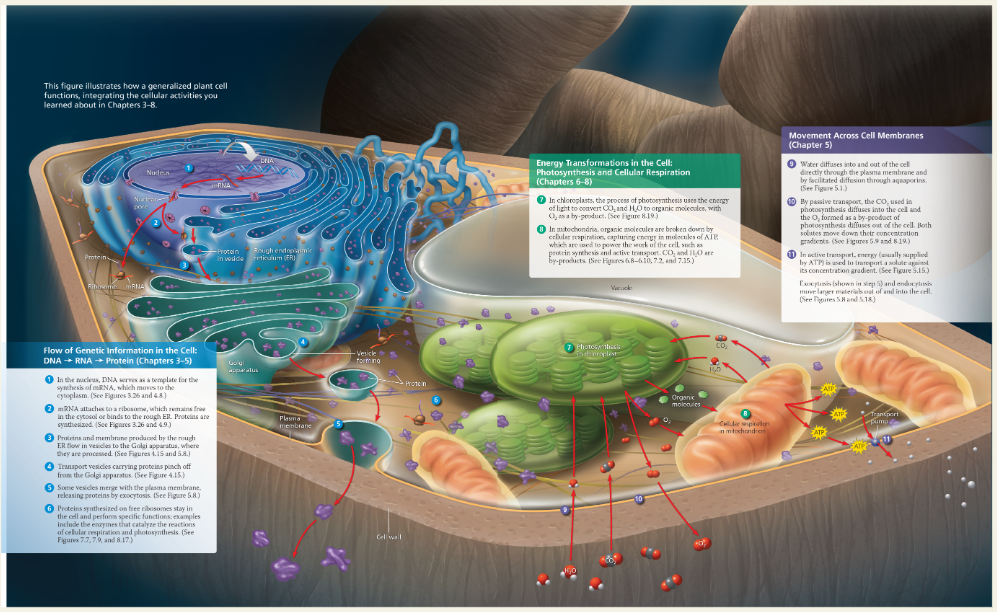
The Working Cell Genetic Information (Chapters 3-5)
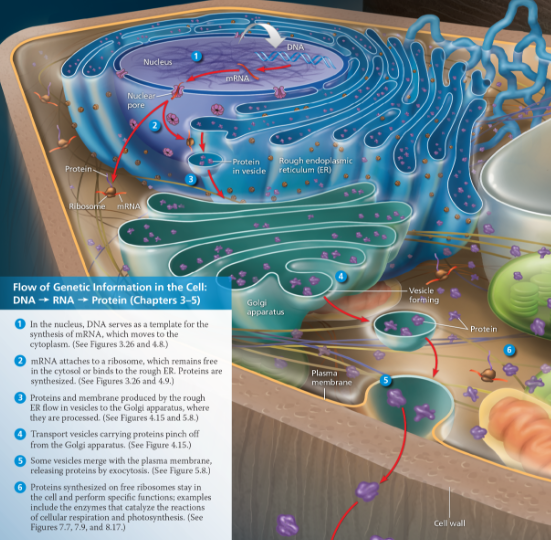
The Working Cell Energy Transformations (Chapters 6-8)
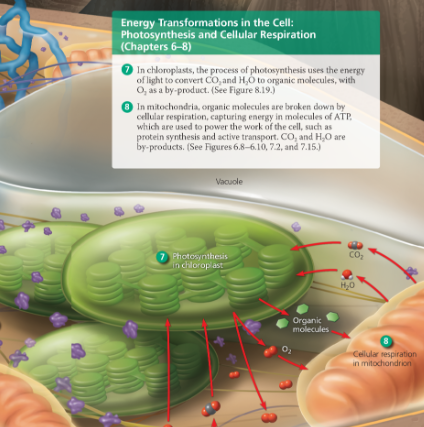
The Working Cell Membrane Movement (Chapter 5)
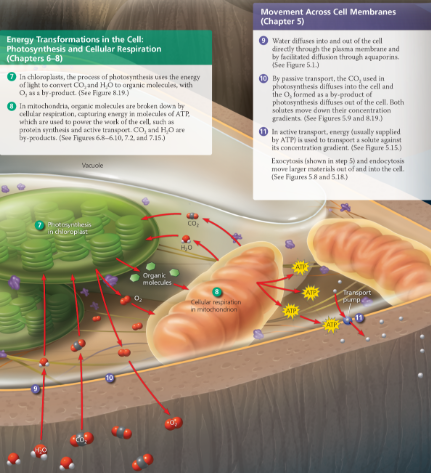
The first enzyme that functions in glycolysis is hexokinase. In this plant cell, describe the entire process by which this enzyme is produced and where it functions, specifying the locations for each step.
The gene encoding hexokinase is part of the DNA of a chromosome in the nucleus. There, the gene is transcribed into mRNA, which is transported to the cytoplasm where it is translated on a free ribosome into a polypeptide. The polypeptide folds into a functional protein with secondary and tertiary structure. Once functional, it carries out the first reaction of glycolysis in the cytoplasm.
How are the large numbers of ATP and NADPH molecules used during the Calvin cycle consistent with the high value of glucose as an energy source?
The more energy and reducing power a molecule stores, the more energy and reducing power are required for formation of that molecule. Glucose is a valuable energy source because it is highly reduced, storing lots of potential energy in its electrons. To reduce CO2 to glucose, a large amount of energy and reducing power are required in the form of large numbers of ATP and NADPH molecules, respectively.
Explain why a poison that inhibits an enzyme of the Calvin cycle will also inhibit the light reactions.
The light reactions require ADP and NADP+, which would not be formed in sufficient quantities from ATP and NADPH if the Calvin cycle stopped.
Describe how photorespiration lowers photosynthetic output.
Photorespiration decreases photosynthetic output by adding oxygen, instead of carbon dioxide, to the Calvin cycle. As a result, no sugar is generated (no carbon is fixed), and O2 is used rather than generated.
Draw where ATP and NADPH are used and where rubisco fucntions and describe these steps

In the reduction phase of the Calvin cycle, ATP phosphorylates a three-carbon compound, and NADPH then reduces this compound to G3P. ATP is also used in the regeneration phase, when five molecules of G3P are converted to three molecules of the five-carbon compound RuBP. Rubisco catalyzes the first step of carbon fixation—the addition of CO2 to RuBP.